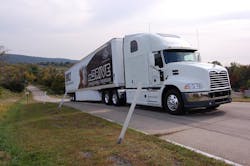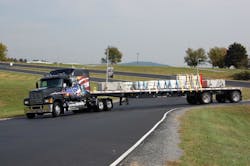I got a recent lesson in this during a recent visit with Mack Trucks at its customer center outside Allentown, PA; a facility that used to serve as the OEM’s research, development, and testing grounds from it’s opening in 1976 until 2010.
[Mack Trucks also held a ride and drive for visiting journalists, too, as part of this event and you can view more pictures by clicking here.]
David McKenna, Mack’s director of powertrain sales, walked me through how the OEM is tying its proprietary Mack line of engines – in this particular case its MP8 unit – to its 12-speed mDrive automated mechanical transmission (AMT) and C125 rear axle carrier to boost fuel efficiency by upwards of 3.5% in some cases. The engine/mDrive connection is worth about 2% of that equation, with the rear axle carrier generating 1.5% of it.
McKenna explained that it’s important for truck operators to realize that bigger no longer necessarily translates into better when it comes to engine displacement anymore as lighter displacement engines can now generate sufficient torque to meet about 95% of trucking’s performance needs.
“It’s important to remember that torque determines the amount of work an engine can do while horsepower describes the speed at which that work can be done,” he told me.
“By adjusting the fuel map strategy of our engines, in combination with sharing more detailed information between the transmission and engine, we can provide more torque in the top two gears than before – above 200 ft-lbs more,” he said. “That means a driver can stay in the top two gears longer and not downshift; or, if they have to downshift, only drop one gear, not two. And staying in that top range is the where you hit the ‘sweet spot’ for fuel economy.”Improvements to other components also help in the push to gain more fuel economy as well. In Mack’s case, take its new Twin Y suspension package. Compared to Mack’s previous AL-401 suspension, the Twin Y is lighter by about 400 lbs.
Not only does it save weight, but Jerry Warmkessel, the OEM’s highway product marketing manager, said pilot testing with customer fleets indicated that the Twin Y can also improve rear axle tire wear by 25% – adding some extra savings to the bottom line as well.
And as the cost of trucking operations only continues to climb as driver wages increase, fuel prices stay higher, and regulatory burdens grow, every penny saved is going to make a big difference.


